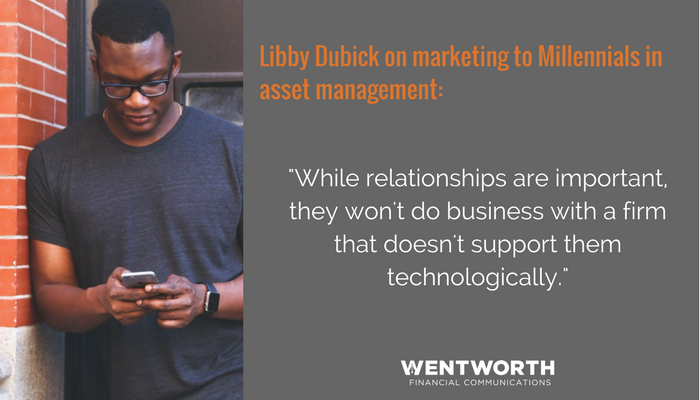With Millennials set to inherit an estimated $40 trillion from aging Baby Boomers over the next several decades, it’s no surprise that asset management firms have spent a tremendous amount of energy trying to figure out how to crack the Millennial code.
While most of the research into marketing to Millennials, the generation born from 1980 to 2000, has focused on how they differ from previous generations in terms of their spending habits, communication styles, investment priorities, and media-consumption habits, one investment marketing professional urges asset managers to start by understanding what Millennials have in common with older generations.
Libby Dubick, the head of an agency that helps financial services firms optimize their marketing and distribution strategies, said that there are many important similarities between Millennials and older generations—and these similarities have important implications for how asset managers market to Millennials. Like older generations, Millennials say that family is their top priority, are moderate in terms of their risk tolerance, value expertise when selecting a professional advisor, and will need more financial advice as their lives get more complicated.
 Despite these similarities, Dubick said that there are, indeed, significant differences between Millennials and older generations that financial marketers should be aware of. In terms of how they spend their money, Millennials value experiences over owning material goods. When it comes to what types of messages and brands resonate with them, authenticity trumps nearly all other characteristics for Millennials.
Despite these similarities, Dubick said that there are, indeed, significant differences between Millennials and older generations that financial marketers should be aware of. In terms of how they spend their money, Millennials value experiences over owning material goods. When it comes to what types of messages and brands resonate with them, authenticity trumps nearly all other characteristics for Millennials.
“These have important implications for financial services firms,” Dubick said in her presentation to fellow asset management marketing professionals at PAICR’s 2017 annual conference in New York City, where the theme was “Build. Measure. Learn. Repeat. Agile Marketing in the Age of Disruption.”
Lessons for Connecting With Millennials
Drawing on research conducted by her firm, Dubick & Associates, and third-party research, Dubick examined how Millennials are disrupting the financial services industry and what companies can do to attract Millennials as clients and employees. Here is a quick look at some of her recommendations:
- Prepare non-linear financial plans: Over the past century, Americans have followed the traditional financial lifecyle of 1) getting a job, 2) raising a family and saving for retirement, and 3) retiring and then spending money on travel and other adventures. Dubick said that Millennials will be the first generation in which a large percentage of them want to deviate from this pattern and lead “non-linear” lives. Dubick cited research from Allianz showing that 70% of Millennials prefer to “explore, experiment, and travel” before retirement. Dubick said that these new patterns create different challenges for financial advisors and asset managers. Rather than a client’s life being neatly divided into two main stages, accumulating wealth and spending wealth, advisors need to be prepared to create financial plans that account for Millennials’ desire to pursue the goals of saving and spending simultaneously.
- Don’t discount the power of social media: Social media has changed the way that people look for financial advice. Dubick cited a Nielsen study showing that 85% of Millennials said that they trusted the opinion of someone they know more than traditional marketing. Financial advisors and asset managers need to realize that Millennials are likely to check out an advisor’s LinkedIn, Facebook, and Twitter pages as part of their regular due diligence. But compliance restrictions are handcuffing firms’ capabilities to fully utilize these platforms. “Firms are struggling with how to take advantage of social media and figure out how to make it work,” Dubick said.
- Upgrade your technology game: Having robust technology platforms that give Millennials convenient access to their account information and that enable other functionality, such as meeting virtually and communicating via text, has become table stakes for investment firms wanting to court younger clients. “While relationships are important to Millennials, they won’t do business with a firm that doesn’t support them technologically,” Dubick said. Unfortunately, many firms are handcuffed by legacy systems that make it very difficult to get away from paperwork and other ways of doing business that may seem anachronistic to Millennials.
- Use relevant examples in your marketing communications: Dubick said that she has encountered pitches by investment companies that use IBM as a case study on investing in technology stocks. She said that regardless of how cutting edge Big Blue’s research into artificial intelligence may be, IBM probably isn’t top-of-mind for today’s digital natives. Dubick said that firms should tailor their marketing materials to Millennials by using examples that will resonate with a younger audience.
- Speak to their interest in thematic investing: Rather than looking to invest in specific companies, regions, or asset classes, Millennials prefer to invest in themes, especially ones that align with their personal values. For example, Millennials may seek to invest in disruptive technologies or long-term demographic trends, Dubick said. Also, environmental, social, and governance (ESG) factors will continue to grow in importance as Millennials gain more clout as investors. Asset managers need to adapt their marketing approaches to reflect these growing trends.
- Don’t confuse a lack of formality with a lack of seriousness: One of the most obvious differences between Millennials and older generations is the degree of formality that Millennials use in their speech and their dress. You don’t have to spend much time on Twitter or Facebook to see how the loosening of formal restrictions is shaping 20- and 30-somethings’ communication styles. As an example of shifting expectations in terms of acceptable dress codes, Dubick pointed to the media kerfuffle in 2005 when several members of the Northwestern University women’s lacrosse team wore flip flops on their trip to the White House to meet President George W. Bush.
Dubick said that asset managers, when marketing to Millennials, need to consider adapting their style to reflect the new norms. In terms of marketing, Dubick said firms should consider adapting both the tone of their language and their communication formats to meet Millennials on their ground. But, Dubick warned, asset managers shouldn’t mistake Millennials’ lack of formality as a lack of seriousness about a topic. Just because they don’t expect their financial advisor to wear a suit and tie to meetings or communicate with them via formal letters, that doesn’t mean that Millennial clients have lower expectations in terms of the amount of rigor that they demand from their advisors.
Adopting a more conversational tone in your marketing communications is a topic that Tucker Slosburg and I explored in our presentation at the PAICR conference. To learn how to convey a more relevant voice in a disrupted media landscape, check out “Do Emojis, Hashtags, and GIFs Belong in Your Financial Writing?”
Managing Millennial Workers
When it comes to managing Millennials in the workplace, Dubick said that it is important to remember that Millennials, by and large, have been given more personalized attention from their parents than previous generations—so they expect to receive this level of attention from their bosses as well. Dubick said that managers of Millennial employees need to be prepared to provide explicit directions about how they want tasks done—as well as explain why they want things done.
Whether managing Millennials or marketing to them, Dubick said it’s important for asset managers to realize that every generation differs significantly from the one that came before it. “The generation gap is not a new thing,” said Dubick, herself a Baby Boomer. “My generation famously said, ‘Don’t trust anyone older than 30.’”
About the Author
 Scott Wentworth is the founder and head financial writer at Wentworth Financial Communications. Scott and the team of writers and editors at WFC help professionals across the financial services industry build their brands by creating investment-grade white papers, bylined articles, newsletters, blogs, social media posts, and other forms of content marketing. Born in September 1979, Scott missed being a Millennial by three months, so if he ever gets invited to the White House, he probably wouldn’t wear flip flops.
Scott Wentworth is the founder and head financial writer at Wentworth Financial Communications. Scott and the team of writers and editors at WFC help professionals across the financial services industry build their brands by creating investment-grade white papers, bylined articles, newsletters, blogs, social media posts, and other forms of content marketing. Born in September 1979, Scott missed being a Millennial by three months, so if he ever gets invited to the White House, he probably wouldn’t wear flip flops.
